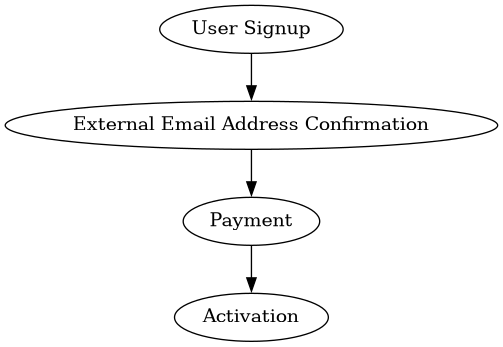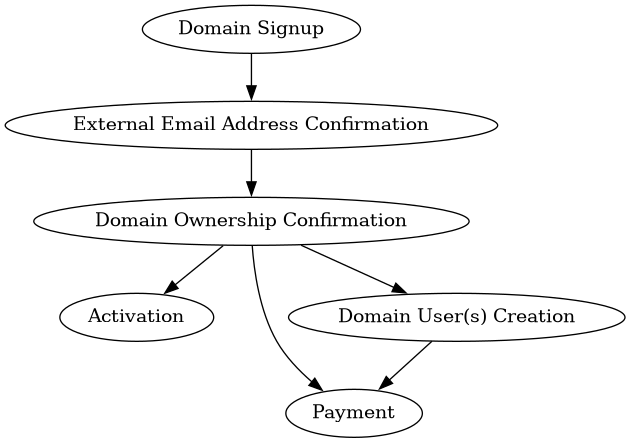Hosted Kolab Groupware Deployment¶
A Hosted Kolab Groupware Deployment consists of at least two separate parent domain name spaces.
It’s intended use case is to allow the sale of accounts, whether they be individual user accounts, or domain accounts, and whether they require payment (for example, MyKolab.com) or not (for example, Kolab.org Demo).
The first parent domain name space is referred to as the management domain.
This is typically the location for service users, and users servicing the systems (such as system administrators and support staff), as well as privilege and permission groups (for example,
sysadmin-maingroup membership to allow the use ofsudo).The second parent domain name space is either the first of many hosted domains, or the primary hosted domain.
A primary hosted domain is typically open for user self-registration, such as https://demo.kolab.org via https://kolabsys.com/try
![digraph {
label="Hosted Kolab Groupware Deployment - LDAP Layout";
subgraph cluster_kolabsys {
label="Management Domain";
"dc=kolabsys,dc=net" -> "ou=Groups" [dir=none];
"dc=kolabsys,dc=net" -> "ou=People", "ou=Special Users" [dir=none];
"ou=People" -> "uid=sysadmin1", "uid=sysadmin2" [dir=none];
"ou=Special Users" -> "uid=cyrus-admin", "uid=kolab-service" [dir=none];
}
subgraph cluster_mykolab {
label="Primary Hosted Domain";
"ou=People 1" [label="ou=People",dir=none];
"dc=mykolab,dc=com" -> "ou=People 1" [dir=none];
"ou=People 1" -> "uid=jdoe", "uid=jroe" [dir=none];
}
}](../_images/graphviz-557ed45b3d908b82dae5eb035b7b78fc661de6cb.png)
Using this distinction allows a Hosted Kolab Groupware provider to;
Configure its systems to authenticate against LDAP, while maintaining a guarantee no customers are accidentally allowed to do so.
Authorize a service or application user account to create new accounts in the primary hosted domain.
Authorize a service or application user account to read the information of selected domain name spaces.
![digraph {
"dc=mykolab,dc=com" -> "ou=People" [dir=none];
"ou=People" -> "uid=jdoe", "uid=jroe" [dir=none];
"uid=hosted-kolab-service,ou=Special Users,dc=kolabsys,dc=net" -> "ou=People" [label="write access"];
"uid=hosted-kolab-service,ou=Special Users,dc=kolabsys,dc=net" -> "associateddomain=mykolab.com" [label="read access",color=green];
"uid=hosted-kolab-service,ou=Special Users,dc=kolabsys,dc=net" -> "associateddomain=customer.tld" [label="no access",color=red];
}](../_images/graphviz-707fa70303ca288c3575d41984ea243a99142951.png)
Registration and Payment Processes¶
Registration of an email address (to one of the hosted domain name spaces open for user registration), would require some confirmation of ownership, and some means to contact the user.
It is deemed sufficient for a user to specify an external email address, and complete payment, to get an account activated.

Subsequent Changes and Account Suspension¶
Payment is a regularly occuring process, and the amount is subject to changes in user subscriptions.
It is paramount to immediately activate new subscriptions, both in terms of user expectations and because activation of user subscription options during or after payment includes some potential attack vectors.
The account is degraded (some functionality is removed), or de-activated entirely, should payment become overdue.
Domain Registration Process¶
A domain registration process is more complicated, since before the domain is active (even within the environment it is registered in), ownership of the domain needs to be confirmed.
If this crucial step is not taken, the environment is subject to a variety of internal attack vectors, including phishing.

User Registration¶
If one or more domains are open for user registration,
Domain Registration¶
Differentiating Access Levels¶
Establishing different access levels in a hosted Kolab Groupware environment allows a provider to associate different features with costs incurred to the customer.
Among other levels, the following levels of access could be defined:
Web client access,
Plugins for the web client on a per-plugin basis,
Settings-based features for the web client, on a per-setting basis,
Direct IMAP access (for desktop clients and other IMAP clients),
Server-side filtering (Manage Sieve),
Mobile device synchronization through ActiveSync,
CalDAV/CardDAV access,
WebDAV access
The methodology to distinguish access levels is based on authorization parameters such as the roles associated with a user’s account and/or group membership. Kolab Groupware recommends using roles, as they are far more scalable than group membership, to establish authorization to services.
An example scenario building a hosted Kolab Groupware environment could be to require additional payment for the use of ActiveSync to synchronize mobile devices, whereas all other services and access levels are included in a base price for the account.
The following roles would be defined, with their associated access levels:
cn=activesync-user,dc=mykolab,dc=com,A user of ActiveSync. This role is typically added when the user selects the option, and authorizes the user to use mobile device synchronization through ActiveSync.
cn=imap-user,dc=mykolab,dc=com,A regular user account. This role is typically added after the user’s account has received initial payment.
cn=suspended-user,dc=mykolab,dc=comA suspended user has overdue payments, and could therefore not be allowed to send any email any longer.
It is generally considered prohibitively punitive to not allow the user to access his/her data any longer, and therefore this is considered an intermediate state for the account to allow timely recovery of full functionality.
A deployment could opt to also suspend delivery to the account, but should bear in mind that delivery failure is likely considered data loss.
Multiple Parent Domain Root DNs and Access Levels¶
When using roles to establish access to applications or features including the Kolab Web Client, any of its plugins, Chwala, iRony and/or Syncroton, an environment with multiple parent domain name spaces must take into account the names or roles are variable.
The kolab_auth plugin for the Kolab Web Client, responsible for using roles to determine additional plugins to enable, and settings to enforce, can use the following syntax to allow a single set of definitions to apply to multiple root dns:
cn=imap-user,%dc
%dc is expanded to the domain root dn. See
Mapping a Domain Name Space to a Directory Tree Root DN for more
information.
Multi-Domain Hosted Environments and SSL Certificates¶
A hosted Kolab Groupware environment with customers registering their own domain name spaces instructs them to use addresses for services in the primary hosted domain by default. The primary hosted domain should have a valid SSL certificate signed by a publically trusted certificate authority.
For an example customer example.org, therefore, the location for the web client would be https://webmail.mykolab.com, and the IMAP server would be imaps://imap.mykolab.com. Users in the example.org domain would login using their full email address.
Should a customer require a dedicated SSL certificate to their domain, so that the customer’s users can use https://webmail.example.org and/or imaps://imap.example.org, it is important to take into account that therefore the domain name space needs to be associated with a dedicated public IP address.
While modern browsers can deal with the HTTP host header negotiation prior to encrypting the connection, most mobile devices can not.
In other words, while https://webmail.example.org (for modern browsers) does not strictly require a unique service IP address to be associated with it, you must consider that https://activesync.example.org/Microsoft-Server-ActiveSync does.
Furthermore, auto-discovery protocols often mistakenly assume addresses such as https://autodiscover.example.org and https://example.org contain valid automatic configuration, and sometimes fall back to, and sometimes do not even have implemented at all, the query for SRV records such as _autodiscover._tcp.example.org, which is eligible to contain a value pointing to another web server http host address (that an SSL certificate is available for).
Using a dedicated service IP address resolves an issue with desktop clients as
well; The use of addresses such as imap.example.org and smtp.example.org
would trigger an alert about the validity of the SSL certificate used, if the
service IP address for these DNS records pointed to the same service IP address
as those DNS records used for the primary hosted domain.
Setting a Domain Base DN¶
Hosted Kolab Groupware deployments that choose to allow users to register
domain names should consider setting the domain_base_dn setting in the
[ldap] section of kolab.conf(5) to a location in a directory tree that
is a database, and can therefore be indexed and replicated.
In the example referred to previously, this would look as follows:
